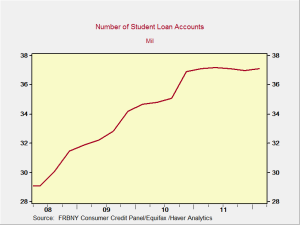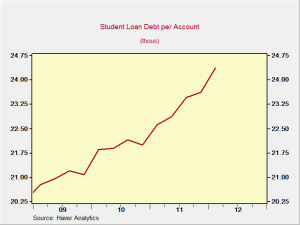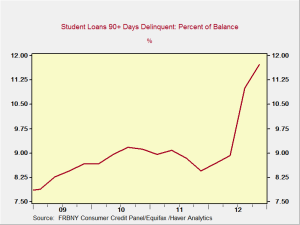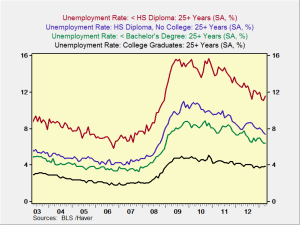One of the things I’ve been keeping an eye on is student debt, widely touted as the next bubble. As you can see in the following chart, student debt is at an all-time high, approaching a trillion dollars.
The absolute dollar amount seems scary, but the trend above looks stable, suggesting no particular reason for alarm. When we look at the details, though, things start to get interesting. Even as the dollar amount continues to increase, the actual number of loan accounts has stabilized over the past couple of years, as shown below:
Given that the total amount of debt has increased while the number of accounts has leveled out, the debt per student has grown, as follows:
There are a couple of caveats worth noting here. First, the data has some weaknesses, so we want to take it with a grain of salt. Second, this is a short time series. Still, there are some interesting points we can take away.
The first is that the average student debt per account increased by almost 20 percent in three years—and has no doubt increased more since then. Now, there’s nothing wrong with accruing debt, as long as it’s invested in an asset that can pay off both the interest and the principal. Unfortunately, that’s increasingly not the case, as delinquencies are rising.
Let’s recap. Student loan debt continues to rise, while the number of loans has stabilized, and so the debt per student has continued to rise. We’ve also seen the delinquency rate on student loans increase substantially in the past year, even as the economy has improved.
There are a couple of possible reasons for this. First, jobs for new college grads may just not be there, and the delinquencies are the result of unemployment. Second, new grads may be getting jobs, but not at wages that support their debts.
Evidence suggests the latter. As the chart below shows, the unemployment rate for college grads continues to track well below the unemployment rates for those with less education. Moreover, the gap got considerably wider during the financial crisis and is still much greater than it was in the mid-2000s.
Looking at wages is harder, due to a lack of data sorted by education. The slow overall growth in wages in recent years, however, suggests that the rising level of education in the population isn’t translating to higher wages. This is supported anecdotally, with many grads taking jobs that historically haven’t required a college degree.
What this means overall is that, increasingly, the wage premium for a college degree is being expressed as a higher employment rate alone, rather than a higher employment rate and a higher wage. In short, the income premium is eroding even as the price of a college education increases.
To me, this says that we can expect default rates to continue to rise, as wages simply don’t support the costs. Moreover, the damage to the future economic status of current grads is likely to persist; people who start careers in tough times typically have lower incomes over their entire life. The problem with current defaults won’t be fully resolved by growth.
That said, because student loans cannot be cleared, the ultimate damage to lenders is likely to be less. The real damage will be to the students, who may find themselves hobbled in their ability to make major life commitments, like buying a house.
Colleges will also be affected. Just as with the housing crisis, when the availability of financing eroded, the bubble in pricing ended. As the wage premium erodes, colleges’ ability to charge more will erode as well.
Coupled with the online education trend that I’ve written about before, higher education will come under increasing cost pressure. Although premium markets with limited supply will continue to do well, the price pressure will hit hardest on mid-market colleges. Harvard won’t have to worry, but other schools will.
This is already happening. An article in today’s Wall Street Journal lays out the increasing tendency of schools to discount tuition in the face of dropping attendance. This is a trend in its early days, and you can expect to hear quite a bit more in the next couple of years.


 Print
Print







